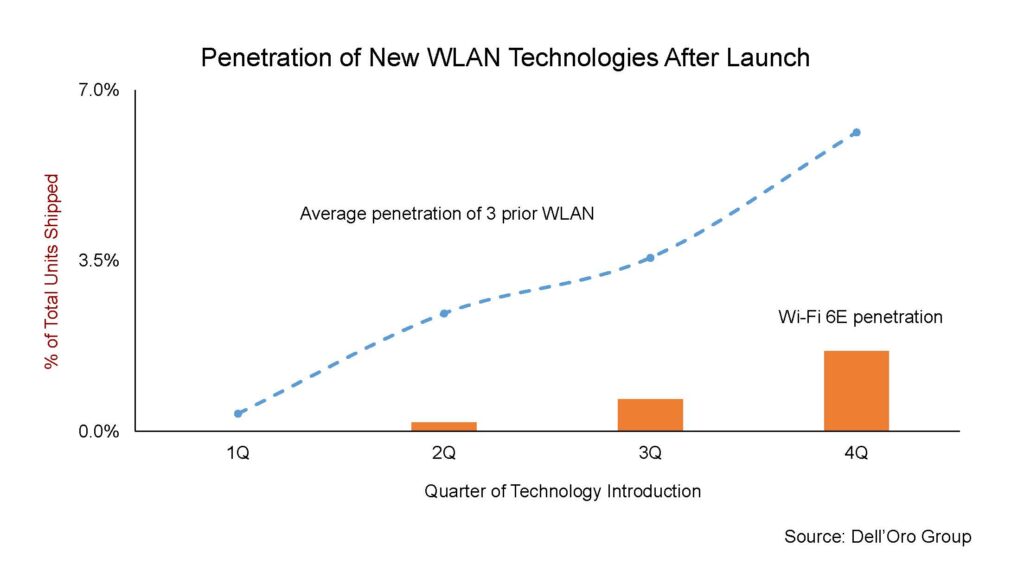The thought of Wi-Fi 6E has had technologists salivating over access to pristine spectrum. It is like having the beach front to yourself. No traffic from other users. No one getting sand on your towel.
From a protocol stack perspective, Wi-Fi 6E is the same standard as Wi-Fi 6: 802.11ax. The breakthrough is that it can operate in the 6 GHz spectrum, previously unavailable for Wi-Fi.
In May 2020, Tam Dell’Oro wrote about the FCC’s decision to attribute this frequency for unlicensed use in the US. She explained the move opened the door for Wi-Fi to rival 5G in IoT applications. It increased available spectrum by a nearly five times, improving rural connectivity. Dell’Oro predicted that Europe and countries in the Middle East would follow in allocating this band for Wi-Fi use. (For an updated view of which countries have adopted the new frequency for Wi-Fi, see here.)
Since then our lives have been turned upside down by a two and a half-year pandemic. Hybrid work is the new reality. Designated workstations are gone and efficient hot desking needs good Wi-Fi coverage. With large swaths of the work-force at home, LAN traffic patterns have changed. On the day that everyone comes to the office, the Wi-Fi is stretched to capacity.
The pandemic has thrown another wrench in the works by wreaking havoc with supply chains. Manufacturers have record-level backlogs. Enterprises have been waiting for 6-months to a year to receive their Wireless LAN orders, using older out-of-date gear in the meantime.
By February of this year, storm clouds were brewing on the 6E coast. Enterprises were asking for Wi-Fi 6, not 6E. In addition, chip makers were promising that Wi-Fi 7, which will also use the new 6 GHz spectrum, was not far off. “If you look at the signals, the direction they’re pointing to is that 7 is going to be the upgrade; 6E is going to be the niche,” stated Dell’Oro in an interview with RCR Wireless.
Now, Enterprise-class Wi-Fi 6E has been on the market four quarters and it is time to take a look at the hard numbers. How is Wi-Fi 6E stacking up in terms of shipment volumes?

Shipments have been, well … underwhelming. When compared to an average of the three prior WLAN technologies (Wi-Fi 5 Wave 1, Wi-Fi 5 Wave 2 and Wi-Fi 6), Wi-Fi 6E has shipped at one third the rate. Let’s take a look at what could be holding things back.
- Slow take up by WLAN manufacturers. At the writing of this blog, there are over half a dozen companies shipping enterprise-grade Wi-Fi 6E. However, when the first 6E WLAN Access Point shipped in the third quarter of 2021, there were only two vendors with products. The next vendor did not start shipping for another two quarters, an unusually slow adoption. The next few points may explain why manufacturers have been sluggish to jump aboard.
- Lack of products due to supply chain problems. Every WLAN vendor outside China would be selling more units if they could produce them. Because it supports a third frequency band, Wi-Fi 6E requires more components than older versions of Wi-Fi, an impediment when supply is short. However we did see a 12 percent Y/Y growth in unit shipments in the second quarter. If the margins were compelling, vendors would be prioritizing Wi-Fi 6E products. The supply chain problems are a complication, but there are other factors at play.
- Worldwide applicability. While 28 countries have allocated the 6 GHz band for Wi-Fi use, several have not. In particular, China, whose enterprises purchased nearly 30 percent of the world’s units last year, has not approved this spectrum for Wi-Fi use. To test whether the lack of Chinese demand was hampering worldwide adoption, we took a look the data excluding this market. The analysis showed that outside China, after four quarters of availability, Wi-Fi 6E shipments are still only 35% of the average penetration achieved by the last three technologies. Clearly, there must be other causes of the slow adoption.
- Restrictions on outdoor use and potential interference. Both the FCC and the CEPT in Europe have approved Wi-Fi 6E for indoor use. It is not permitted for Effective Isotropic Radiated Power (EIRP) levels above 30 dBm in the US or 24 dBm in Europe. Wi-Fi APs transmitting outdoors in the 6 GHz band can interfere with critical applications already using the frequency. Interference with utility or railway control systems could have catastrophic consequences. In the US, for an AP to operate at “Standard Power” (needed for outdoor applications), it must first consult an Automatic Frequency Control system. Several organizations have applied to become AFC system operators, but the process has not been finalized. Manufacturers are keen to begin outdoor deployments — two have already announced outdoor 6E APs. However, for the past five years, outdoor APs have represented only about 4% of the total units shipped. This leaves us with one more possible reason holding 6E deployments back.
- Support on end devices. Although many of the high-end lap tops and mobile phones support Wi-Fi 6E, there are still many legacy PCs and smartphones in use. In addition, Apple left 6E out of the latest iPhone 14 launch in September. Until there is support in mainstream enterprise-class PCs and mid-tier mobile devices, Wi-Fi 6E will not be widely adopted.
Despite its slow start, there are some interesting things happening with Wi-Fi 6E. In July, the University of Michigan completed a project to blanket two campuses, giving students and staff access to HD video streams in their densely populated classrooms and auditoriums. Along another vein, the IoT Work Group at the Wireless Broadband Alliance is investigating Wi-Fi 6E’s ability to meet stringent low-latency requirements for Industrial IoT. As industrial companies depend on more wireless equipment, the new 6 GHz band will be critical. In the meantime, at the Dell’Oro Group, we’ve raised our forecast for Wi-Fi 6, predicting that 6E will remain niche until Wi-Fi 7 becomes available. If you’re on the 6 GHz Wi-Fi beach, you can put up an umbrella and stretch out. It will be quiet for a few more quarters

